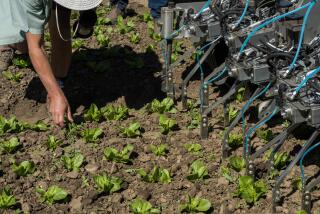GARDENING : Pest Control Without Pesticides
Sharon Whatley likes to know what her family is eating.
And it’s not always easy to find out.
“There is no way to tell what is sprayed on vegetables and fruit before they get to the supermarket, and I wanted to have control over that,” said the Tustin resident.
She started a garden in her back yard six years ago to ensure that her family ate only naturally grown, chemical-free produce.
Then the bugs invaded her pure environment.
“When I began to get garden pests and went to the nursery for advice, they suggested I use harsh chemical methods, which defeated the whole purpose of having a garden,” she said.
Whatley began searching for alternatives to chemical pest control. She conducted research on her own and then hooked up with the Orange County Organic Gardening Club. She now controls pests organically.
The Orange County Organic Gardening Club offers members and guests educational programs, speakers and demonstrations. The group meets every second Tuesday of the month at Mercury Federal Savings in Tustin. Seventy families are members of the 25-year-old club.
Club members say you can trash the chemicals and start fresh. By using alternative pest-control methods, back-yard gardeners avoid the harmful effects of chemicals in the soil and on the produce.
“Your first line of defense against pests is to have healthy plants,” said Bud Anderson, vice president of the Organic Gardening Club. “When plants become stressed because of lack of water or nutrition or start aging, pests will attack them.”
Insects are attracted to yellow--the color of sickly plants. “Yellow means food to them,” said Sharron Clark, a professor of biology at Golden West College who will teach a class on alternative methods of garden maintenance this fall.
Problems can be prevented by selecting strong, healthy green plants. After planting, be sure to keep the area free of debris and remove any yellowing leaves or ailing plants.
Another important element to consider during plant selection is disease resistance. You can prevent infestations by choosing plants that can ward off certain devastating diseases.
When selecting tomato plants, for instance, look for the VFN label, which indicates that the plant is resistant to three main types of deadly soil-borne diseases. Seed packages also indicate that plants are resistant.
Pests thrive, too, on young, tender plants. Start seeds in containers and transplant them when they’re the size of plants found in the nursery.
“To protect transplants, put a newspaper collar around the stems,” said Clark. “This will keep cutworms and other pests away. As the plants grow, the newspaper will disintegrate.”
Once pesky insects are spotted, there are several organic chemical control methods that can be used. Insecticidal soaps are a popular, safe way to suffocate aphids, white flies and mealybugs, while not harming friendly predators such as lacewings, ladybugs and praying mantises. These soap solutions can be made at home or purchased.
To mix your own, put a few drops of dish detergent into water and spray it on your plants. If you want a stronger solution, mix fresh onion juice, garlic and hot pepper into the soapy water. After some experimentation, every gardener comes up with his or her own favorite mixture.
Effective, readily biodegradable insecticidal soaps--like Safer--can be found in most gardening centers. These are designed to kill aphids, mealybugs, whiteflies, mites, tent caterpillars, thrips and other destructive pests. Spray in the early morning or late afternoon to avoid leaf burn.
Another chemical that acts as a stomach poison for beetles, thrips, weevils and borers is Rotenone, which is an extract from the roots of tropical legumes. It is usually found in a combination spray with Pyrethrum. This comes from the flower heads of the Pyrethrum Chrysanthemum, a form of the daisy found in Africa. Pyrethrum kills leaf hoppers, thrips, whiteflies and aphids.
When using organic chemical sprays, keep in mind that their effects don’t last long, which is why they don’t become part of your food. If pests persist, sprays must be reapplied.
Another form of controlling pests is through biological means. “So that we are not overrun by any one species in nature, organisms feed on one another,” said Clark. “You can use such biological controls in your own garden.”
A good cure for soil-borne pests such as pill bugs, sow bugs, snails and slugs is Diatamascious Earth. “This is made up of the shells of a small sea creature which is mined from the ocean floor,” said Anderson. “When it is mixed into the soil, the pests eat them and the sharp edges tear up their insides.”
Another control is the bacteria Bacillus Thuringiensis, which can kill all kinds of caterpillars, fly larvae and worms. “When you see holes in leaves and vegetables such as tomatoes and actual caterpillars and worms on your plants, spray them with this solution and the pests will soon die from eating the leaves and ingesting the bacteria, which poisons their guts,” said Clark. This product is sold under the brand names Attack and Dipel and is readily available.
You can also control pests by introducing certain “good” insects into your garden, such as ladybugs, praying mantises, lacewings, spiders and wasps. Many of these can be bought at the nursery and set free in your garden.
Barrier methods are also effective in controlling some pests. Whatley has found that a shallow pan or dish filled with stale beer and soap stops snails as they attempt to climb into her garden. Salt also harms the troublemakers. Stop snails by putting salt on cardboard strips and placing them around the outskirts of your garden. Avoid getting salt into the soil.
Netting is another effective barrier method for plants such as broccoli and cauliflower. This prevents the white cabbage butterfly and other similar insects from laying eggs on the plants.
Certain companion plants deter pests.
“Because of their pungent odor, marigolds ward off many pests,” said Anderson, who has them planted throughout his garden. Nasturtiums are attractive flowers that repel aphids and squash bugs. Plant them near cabbage, lettuce, squash and radishes. Some herbs are also useful.
“We enjoy the odor and taste of sweet basil, but tomato and cabbage worms don’t like it,” said Anderson. Mint, too, deters many pests that affect cabbage and tomatoes.
Don’t bunch similar crops in the same area. “Nature doesn’t have all of the same tree in one spot or a meadow filled with pure grass,” said Clark. “When we plant all one crop in one area, we upset the balance of nature, and this encourages pests, because each type tends to feed on similar crops.
“For instance, if you have rows of lettuce, the insects who feed on that will move readily from plant to plant and destroy your crop. However, if you interplant dissimilar crops between rows and within rows, when an insect is feeding on lettuce and then moves over to radishes, it is likely to find this vegetable distasteful.”
Many organic gardeners use truly simple solutions: water and picking bugs off leaves. Aphids can often be killed with a strong jet of water, while many caterpillars, worms and snails can be picked from plants. To catch sow bugs and pill bugs, place a piece of wood in the garden and they will crawl under it. “Don’t kill the blue sow bugs, though,” said Clark. “They have a disease that will kill the other ones.”
Of course, no garden is going to be completely free of pests. “You’re not insect-proof, you’re insect- and pest-deterrent,” explained Anderson. “You must remember that all of the ‘pests’ are there for a reason--they actually have a place in the earth’s continuum. We don’t want to destroy everything, which is why alternative methods work so well. They create a natural balance in your garden.”
Since she started using alternative methods, Whatley’s pest problems have decreased. “Five years ago, when I used toxic chemical controls, I constantly battled pests,” she said. “Today I don’t have very many problems. My garden is really healthy, and I’m able to eat produce that is chemical-free.”






